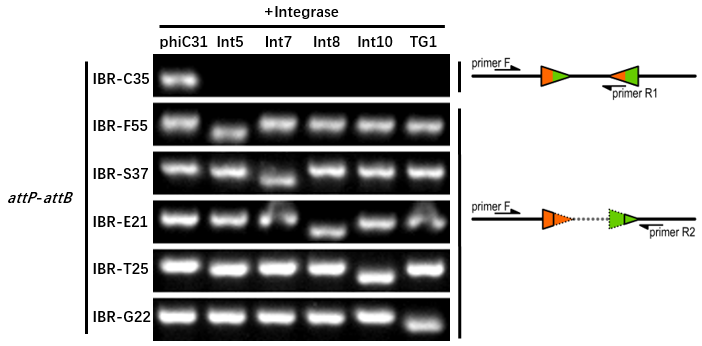Part:BBa_K3254005
TG1attB-BsaI site-terminator-TG1attP
We expected that this part can be placed between a promoter and a translational unit part and work as a normally open (NO) switch for the downstreamed gene. and switch to ON state by excising the terminator L3S3P22 between the att sites when it reacted with TG1 integrase (BBa_K2460007). Two BsaI restriction site were added between attB site and terminator. As a result, it can work as a normally closed (NC) switch for the gene which was inserted between the two BsaI site and switch to OFF state when it was excised.
Usage and Biology
Visual Result as a Normally Open Switch
- We conducted a simple test to see if our design met the expectation.
Experimental Setup
- Genetic design principle of the experimental group is described on the page of BBa_K3254013.
- A P15A-AmpR plasmid was co-transferred into the E.coli DH5α host cell with the reporter plasmid containing this part as the negative control.
- Single colonies were selected from the experimental LB-agar plate and negative control LB-agar plate, then inoculated into EP tubes with 500 μL M9 supplemented medium containing 500 μM IPTG for overnight growth at 37 °C and 200 rpm.
- Tubes were centrifuged at 10000g for 1 min. Then observed the GFP fluorescence of the cell precipitations under blue light.
- M9 medium (supplemented): 6.8 g/L Na2HPO4, 3 g/L KH2PO4, 0.5 g/L NaCl, 1 g/L NH4Cl, 0.34 g/L thiamine, 0.2% casamino acids, 0.4% glucose, 2mM MgSO4, and 100 μM CaCl2.
Results
- IBR-C35/F55/S37/E21/T25/G22 indicate the experimental systems for phiC31/Int5/Int7/Int8/Int10/TG1 respectively.
- We observed the GFP fluorescence from the experimental tube as expected.
Quantitative Characterization of the Normally Open Switch
Experimental Setup
- Bacteria harboring the circuits (see the top part of the result image) first inoculated from single colonies into a flat-bottom 96-well plate for overnight growth. Then, the cell cultures were diluted 1000-fold with M9 supplemented medium with 500 μM IPTG inducer and growth for another 20 hours. All incubations were carried out using a Digital Thermostatic Shaker maintained at 37 °C and 1000 rpm, using flat-bottom 96-well plates sealed with sealing film. Finally, 3-μL samples each culture were transferred to a new 96-well plate containing 200 μL per well of PBS supplemented with 2 mg/mL kanamycin.
- The fluorescence distribution of each sample was assayed using a flow cytometry. The arithmetical mean of each sample was determined using FlowJo software.
- The principle of data processing is shown on the result image.
Results
- IBR-C35/F55/S37/E21/T25/G22 indicate the experimental systems for phiC31/Int5/Int7/Int8/Int10/TG1 respectively.
- Compared to other parts, this part performed well.
Thermodynamic Characterization
See the related information on the page of BBa_K3254013.
Orthogonality Characterization
Genetic Design
- The composition and principle of the experimental system are indicated below.
Experimental Setup
- The reporter plasmid contained this part were co-transferred into E.coli DH5α host with 6 integrase generator plasmids.
Then single colonies were inoculated into M9 supplemented medium for overnight growth. Then, the cell cultures were diluted 1000-fold with M9 supplemented medium with 500 μM IPTG inducer and growth for another 20 hours. All incubations were carried out using a Digital Thermostatic Shaker maintained at 37 °C and 1000 rpm, using flat-bottom 96-well plates sealed with sealing film. Finally, The cultures were sampled for genotype PCR testing.
- The principle of genotype identification was shown on the right of results image.
Results
- IBR-G22 was the plasmid containing this part.
- The result indicates that this part can only be recombined by TG1 integrase.
- The sequence (attL or attR) after recombination is GATCAGCTCCGCGGGCAAGACCGTGCTCTTACCCAGTTGGGCGGGA.
Sequence and Features
- 10COMPATIBLE WITH RFC[10]
- 12COMPATIBLE WITH RFC[12]
- 21COMPATIBLE WITH RFC[21]
- 23COMPATIBLE WITH RFC[23]
- 25COMPATIBLE WITH RFC[25]
- 1000INCOMPATIBLE WITH RFC[1000]Illegal BsaI site found at 60
Illegal BsaI.rc site found at 48
| None |


